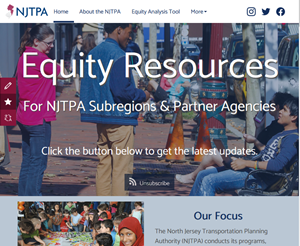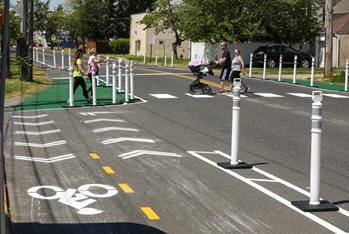April 2022
Posted: 4/29/2022 10:10:59 AM
The NJTPA has launched an Equity Resources website to provide data, guidance and tools to help improve participation by minority, low income and traditionally underserved communities in the transportation planning work conducted and funded by the NJTPA.

The NJTPA requires public engagement and outreach, with a focus on underserved communities, for studies and planning efforts it funds, including those conducted by member subregions – the 13 counties and two cities represented on the NJTPA Board.
The website provides guidance for these efforts. It includes an Equity Analysis tool, which maps areas of traditionally underserved populations using federal data and an Equity Assessment guide that provides detailed ifor identifying populations that have been traditionally underrepresented in the planning process.
The website is being launched as a beta version and the NJTPA welcomes input and comment on its content and usefulness. The website will be presented and discussed at the Planning Tools Expo on May 19, 2022.
This resource supports the NJTPA’s commitment to ensuring that everyone in its region has access to participate in its projects and programs, and that its activities comply with Title VI of the 1964 Civil Rights Act and other federal non-discrimination policies and statues.
Posted: 4/22/2022 1:36:35 PM
 The port serving New Jersey and New York continues its strong growth, driven by new consumer spending patterns and prompting new hiring and redevelopment plans in the City of Newark. Members of the NJTPA Freight Initiatives Committee heard about the growth and its impacts at their April 18 meeting.
The port serving New Jersey and New York continues its strong growth, driven by new consumer spending patterns and prompting new hiring and redevelopment plans in the City of Newark. Members of the NJTPA Freight Initiatives Committee heard about the growth and its impacts at their April 18 meeting.
Committee Chair Jason Sarnoski, Warren County Commissioner, introduced speakers for the annual port and maritime update, noting that the port is a “leading economic engine for the region and the nation.”
Sam Ruda, Director of the Port Authority of New York and New Jersey’s Port Department, said container traffic at the port is 8 to 10 percent above the record levels seen in 2021 and continues to grow. The growth, he said, was driven by “a massive change in personal consumption” favoring goods over services, a trend that accelerated as people ordered online during the pandemic.
At the same time, he said, shippers facing congestion, backlogs and labor issues at West Coast ports are shifting an increasing share of commerce to New York-New Jersey and other, smaller East Coast ports.
As a result, he said, “terminals are operating at full or near full capacity,” running ahead of planned-for levels by six or seven years. At the same time the port faces shortages of truck drivers and chassis and other constraints requiring “complex fixes.” Improvements will be needed to sustain this growth, such as deepening channels from 50 to 55 feet, he said.
The growth has spurred a strong demand for workers, according to John Nardi, President of the New York Shipping Association. The port employs over 3,500 longshoremen and other workers. They were deemed essential workers early in the pandemic, and operations were disrupted as hundreds of workers were idled by the virus, despite efforts to put in place protections.
As operations continued under pandemic-related challenges, Nardi said the port faced a “tidal wave of freight,” requiring the hiring of more workers. But he notes the Port of New York and New Jersey requires thorough background checks before workers can be hired. That check is conducted by the Waterfront Commission, which was jointly established by New York and New Jersey to combat port corruption in the 1950s. Once workers gain experience, they often can earn $150,000 or more a year, he said.
In addition to 581 workers hired from 2018 to mid-2020, the Shipping Association got Commission approval last August to hire 200 additional workers and just initiated requests for nearly 300 more. In addition to helping meet growing freight demand, the hires help replace retiring workers. Due to the nature of work and conditions on the docks, he notes, “it’s a young person’s job.”
The State of New Jersey, he said, is seeking to withdraw from the Waterfront Commission and turn its functions over to the State Police which would speed the hiring process. However, New York is bringing a case challenging the withdrawal to the Supreme Court, which he said presents “interesting” legal issues about bi-state compacts.
Meanwhile, his association is cooperating with the Council on Port Performance to conduct outreach to potential workers and communities in Newark, Elizabeth and surrounding areas.
Facilitating access to port jobs is one of the motivations for a new redevelopment effort, called Forward-Bound Doremus, in the City of Newark, according to Christopher A. Watson, the City’s Planning Officer.
Watson said the effort focuses on five districts adjacent to Doremus Avenue, which runs from the port to industrial and warehousing areas along the Passaic River. The districts include residential areas in the Ironbound.
Among the objectives of the project are to make the corridor a primary employment center for the community, create comprehensive regulations governing development, promote environmental justice and resiliency and strengthen transportation connections for people and goods.
He noted that 9 percent of jobs in Newark are in this area, some of them among the highest paying in the City. However, he said, area residents need better access to the jobs, including programs to close the “skills gap” that hampers their employment.
He said the project seeks to cultivate a “reciprocal relationship” that would link port businesses to local neighborhoods and nearby commercial activities. At the same time, the redevelopment efforts would attract new port-related businesses, including distribution facilities engaged in last-mile deliveries for e-commerce.
Redevelopment, he said, must help address environmental concerns, including flooding in the area. This could include “green” approaches such as permeable pavements for parking lots and using parks to mitigate flood impacts. An assessment of needed changes to zoning and other regulations will help realize these and other objectives, he said.
A recording of the presentations at the Freight Initiatives Committee meeting is here.
Posted: 4/22/2022 8:35:16 AM
Seven municipalities will receive technical assistance for complete streets projects ranging from workshops on walkability to bicycle network plans, conceptual designs and complete streets policies, the North Jersey Transportation Planning Authority (NJTPA) announced today. The municipalities selected through the competitive application process are:
- Bergen County: Oakland Borough – Complete and Green Streets for All Policy
- Essex County: Belleville Township – Temporary Demonstration Project Guidance
- Middlesex County: Dunellen Borough - Complete and Green Streets for All Policy
- Ocean County: Seaside Heights Borough – Walkable Community Workshop
- Passaic County: City of Passaic – Complete Streets Conceptual Renderings
- Somerset County: Bound Brook Borough – Walkable Community Workshop
- Union County: City of Plainfield – Bicycle Corridor or Network Plan
“Complete streets are not only safer, especially for walkers and bicyclists, but they’re also a part of a healthy, equitable community where residents and visitors have options for how to get around,” said NJTPA Chair John W. Bartlett, a Passaic County Commissioner. “This program will help these municipalities move their complete streets visions closer to reality.”
Sustainable Jersey and the Alan M. Voorhees Transportation Center at Rutgers University provide the technical assistance, which the NJTPA funds with federal transportation dollars. Since every municipality has different needs, the program provides technical assistance to help advance complete streets by documenting existing conditions, exploring potential improvements and providing recommendations. Each municipality selected the type of preferred assistance when applying to the program. This includes:
- Bicycle Corridor or Network Plan: To help identifying specific routes and road treatments to improve bicycling infrastructure
- Complete Streets Conceptual Rendering: To prepare graphic renderings to help visualize potential improvements to streetscapes or public spaces
- Temporary Demonstration Project Guidance: To provide guidance on the design and installation of pedestrian safety or bicycle infrastructure temporary safety measures
- Walkable Community Workshop: A workshop and audit of up to a half-mile of street to identify potential pedestrian and bicycle improvements
- Complete and Green Streets for All Guidance: Assistance in the development of a complete streets policy or the update of an existing policy to align with the 2020 New Jersey Department of Transportation Complete and Green Streets for All Policy
“It is valuable for municipalities to receive hands-on guidance to move their complete streets projects forward. Complete and green streets have numerous safety, environmental, equity and health benefits,” said Randall Solomon, executive director of Sustainable Jersey. “This work is an important element in the comprehensive sustainability programs of our communities and contributes to our mission to create a more sustainable New Jersey.”
Complete streets are designed for all users, all modes of transportation and all ability levels. They balance the needs of drivers, people walking and biking, transit riders, emergency responders and goods movement, based on local context.
Improving safety is also a key goal of this program. “Roadway fatalities across New Jersey and the nation have been increasing, especially among people walking and bicycling. We are thrilled to assist communities with complete streets projects that will provide recommendations on making their roadways safer,” said Jon A. Carnegie, Executive Director of the Alan M. Voorhees Transportation Center.
This is the third time the NJTPA is offering technical assistance to municipalities in its region. Eight projects were completed in 2020 and nine projects were completed in 2019. The final reports are available on
our complete streets webpage.
Posted: 4/21/2022 12:08:05 PM
 We’re accepting applications for our Fiscal Year 2022 Planning for Emerging Centers Program! The deadline to apply is May 16 at 4 pm.
We’re accepting applications for our Fiscal Year 2022 Planning for Emerging Centers Program! The deadline to apply is May 16 at 4 pm.
This competitive program provides free technical assistance to help a municipality or group of municipalities with planning studies that advance sustainable transportation and land use planning. This can include planning for development around a transit station, integrated land use/mobility or complete streets implementation. Complete streets are roads designed for users of all ability levels and all travel modes. They balance the needs of pedestrians, bicyclists, drivers, transit riders, emergency responders and goods movement.
Municipalities are required to dedicate in-kind staff time for public and stakeholder outreach, project management, data collection, supplies related to demonstration projects (if applicable), and other tasks as necessary for successful completion of projects. This staff time commitment should be reflected in proposals. No financial match is required.
Past efforts completed through this program include:
-
Borough of Raritan Sustainable Economic Development Plan: This project resulted in the creation of the Downtown Raritan Vision Plan and an Implementation Toolbox. The Plan is a 10-year economic, land-use and multi-modal vision for Downtown Raritan. The Implementation Toolbox will help guide the Borough and partners in implementing the Vision Plan.
-
Borough of Keyport Complete Streets and Implementation Plan: This study created a complete streets ordinance, which upon adoption would prioritize implementing complete streets in all design, planning, construction and maintenance projects. This project also created a Complete Streets Design Guide and Complete Streets Implementation Guide to help identify priority locations and potential improvements.
-
Town of Boonton Transit Village Initiative Planning: The Town of Boonton sought technical assistance to undertake planning efforts that would sharpen its focus on achieving Transit Village designation by NJDOT for the area surrounding the Boonton train station.
Click here for more information about the FY 2022 Planning for Emerging Centers Program solicitation.